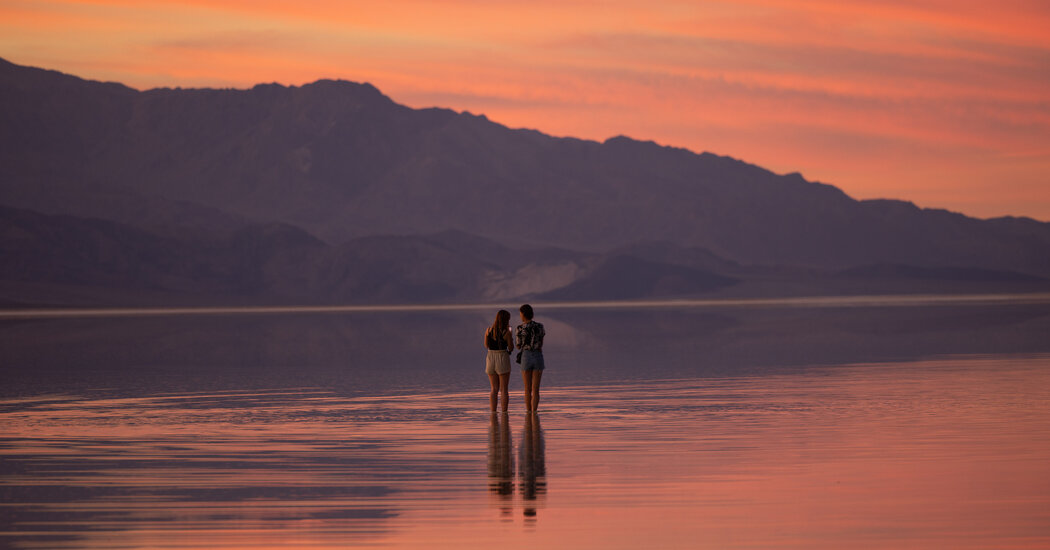Nearly 100 Million Under Temperature Advisories as Heat Wave Lingers
Almost 100 million people across the United States spent the first day of summer on Thursday sweltering in temperatures that topped 90 degrees, as meteorologists warned that the high-pressure system that scorched the country for the past four days would linger through the weekend in many places.
The heat shattered temperature records and altered daily routines from the Midwest river valleys to the pine forests of New England, and left roughly one-third of Americans under extreme heat advisories, warnings or watches on Thursday, according to the National Integrated Heat Health Information System.
In rural Indiana, sheriff’s deputies conducted wellness checks on older residents. In Maine, officials urged homeless people to make use of cooling centers. And in the New York region, students left school early — some because their schools closed at midday, and others because worried parents took matters into their own hands.
Simone Machado pulled her son Bryan, 10, out of school at Ann Street Elementary School in Newark, the largest city in New Jersey, early on Thursday because of the heat. By the time she got there, a bright red heat rash had already bloomed across his neck.
His fourth-grade classroom was “very, very hot,” Bryan said. He was afraid to go back to school on Friday, when temperatures in Newark are forecast to reach almost 100 degrees, but at least it will be the last day of school before summer vacation.
“I don’t want to go. The rashes are going to get worse and worse,” he said. “School’s over tomorrow, thankfully.”
Across town at West Side High School, Jahsir Graham, 15, said that sitting inside his school without air-conditioning had been “excruciatingly painful.”
“It feels like you’re in a boiling pot of water,” he said.
The National Weather Service said on Thursday that the heat wave “will continue over the next several days” and that temperatures could rise even higher still, skirting 100 degrees in some places, especially urban areas in the Northeast.
The heat wave is expected to peak over the weekend in the Northeast, but not until early next week in the South and the Great Plains, the Weather Service said.
Indeed, in some places the worst may be yet to come, including Wichita, Kan., and Lincoln, Neb., where by early next week heat indexes are forecast to reach 100 degrees.
The heat is expected to peak on Friday and Saturday in the Ohio Valley and the Midwest, the Weather Service said. That was promising news in rural Union County, Ind., which borders Ohio and has about 7,000 residents.
The county sheriff, Jeff Adams, said that just about everyone there knows one another. That can make it easier to keep tabs on those vulnerable to the punishing weather, including older residents and those in poor health.
“That can be a double-edged sword, but during this heat, it’s helpful,” he said. “I can tell if they have picked up their mail or whether their curtains are open.”
In Liberty, the county seat, some public employees shifted their work schedules in a concession to the scorching temperatures, clocking in at 5 a.m. instead of their regular 7 a.m. and heading home at 2 p.m., officials said.
At Kehila Coffee in Liberty, the owner, Dara Finch, said customers were also changing their behavior to beat the heat, forsaking hot coffee in favor of something cool.
“I’m selling a lot of iced lattes, and people are buying two drinks,” she said. “One for now, and one for later.”
The heat wave is especially dangerous because of its long duration, the persistence of high temperatures after sunset and the forecast of little cloud cover over the next few days, the Weather Service said.
“Those without access to reliable air-conditioning are urged to find a way to cool down as overnight temperatures will be very warm,” it said on Thursday.
Meteorologists said the heat wave was caused by a heat dome, a high-pressure system in the atmosphere that creates and traps heat like a lid on a pot that holds in steam.
The high-pressure system pushes warm air toward the ground, and the more the air is compressed, the hotter it gets, said Greg Carbin, forecast operations chief at the National Weather Service’s Weather Prediction Center.
By Thursday, all that pressure and heat had already broken or tied temperature records in at least 20 cities across the country, according to the National Weather Service, including Boston, Chicago and Hartford, Conn.
Reporting was contributed by Isabella Grullón Paz, Camille Baker, Nate Schweber, Tim Balk and Kevin Williams.


